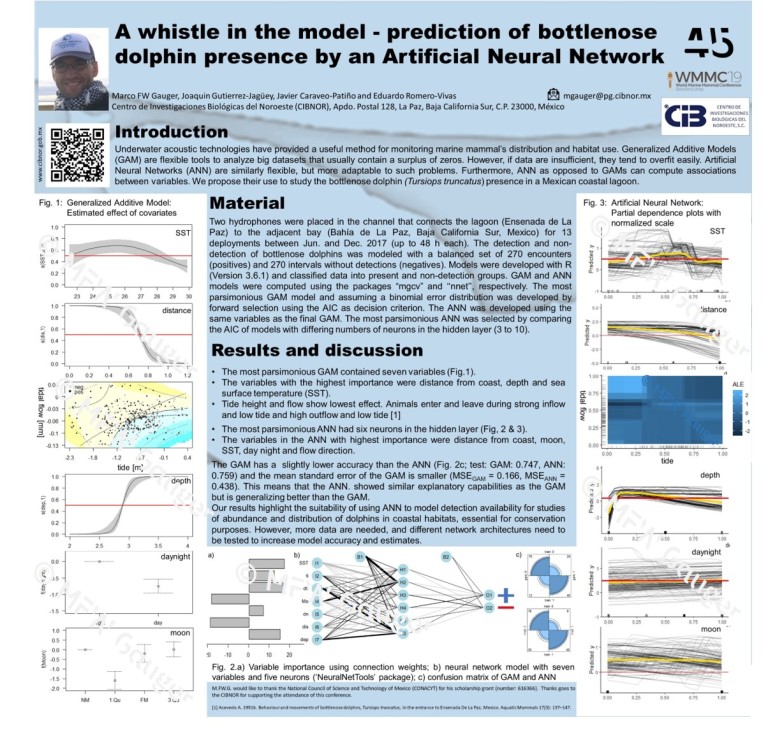During this years’ World Marine Mammal Conference in Barcelona (WMMC 2019) I will present the following poster. Additional details on the study area, the data and their analysis are given here temporallily to augment the information given or if I am not available to give further information. Please see the abstract online https://www.xcdsystem.com/smm/program/rw8aPxB/index.cfm?pgid=728

The study area is the Ensenada de La Paz, a semi-enclosed lagoon surrounded by mangrove vegetation. Several species including fish, birds, turtles and the bottlenose dolphin use this lagoon to nurse and teach their young (Marcín-Medina 2010, Lopez-Rasgado et al. 2012). The bottlenose dolphin is the only known cetacean frequenting the study area (Acevedo 1991, Marcín-Medina 2010; Salsinas Zacarías 2005) although other species occur in nearby waters (Salvadeo et al. 2009, Pardo et al. 2013). More information on the habitat use including day and nighttime presence are studied here to increase awareness and to add information for management and conservation purposes. The water depth (3 – 10 m) is inhomogeneous, hence, recorded vocalizing animals were most likely within the lagoon or the channel.
Custom-made dataloggers were deployed in medium depth in two locations in the entrance and end of the channel that connects the lagoon with the Bahía de La Paz. Whistles were taken as indicator of bottlenose dolphin presence within the study area (May-Collado & Wartzok 2008). They were pooled into encounters when time between whistles was smaller than 10 minutes (Carlström 2005).
As GAMs are sensible colinearity Spearman Rank correlation were run and visualized in a correlation plot. All factor variables as moon phase (New moon, 1. quarter, full moon and 3. quarter) as well as day & night were presented as box plots.
I would like to thank the National Council of Science and Technology of Mexico (CONACYT) for this scholarship grant (number: 616366). Thanks goes as well to the WMMC for supporting the attendance of this conference.
References:
Acevedo A. 1991. Behaviour and movements of bottlenose dolphins, Tursiops truncatus, in the entrance to Ensenada De La Paz, Mexico. Aquatic Mammals 17(3): 137–147.
Carlström J. 2005. Diel variation in echolocation behavior of wild harbor porpoises. Marine Mammal Science 21(1): 1–12. <https://doi.org/10.1111/j.1748-7692.2005.tb01204.x>
López-Rasgado FJ, SZ Herzka, P Del-Monte-Luna, E Serviere-Zaragoza, EF Balart & SE Lluch-Cota. 2012. Fish assemblages in three arid mangrove systems of the Gulf of California: Comparing observations from 1980 and 2010. Bulletin of Marine Science 88(4): 919-945. <https://doi.org/10.5343/bms.2011.1111>
Marcín-Medina R. 2010. Uso del hábitat del tursión (Tursiops truncatus) en relación a factores ambientales y antropogénicos en la Ensenada y sur de la Bahía de La Paz, B.C.S., México. Tesis de Doctorado en Ciencias, Posgrado en Ciencias Marinas y Costeras, Universidad Autónoma de Baja California Sur, La Paz, 133 pp.
May-Collado LJ & D Wartzok. 2008. A Comparison of bottlenose dolphin whistles in the Atlantic Ocean: Factors promoting whistle variation. Journal of Mammalogy 89(5): 1229-1240. <https://doi.org/10.1644/07-MAMM-A-310.1>
Pardo MA, N Silverberg, D Gendron, E Beier & DM Palacios. 2013. Role of environmental seasonality in the turnover of a cetacean community in the southwestern Gulf of California. Marine Ecology Progress Series 487: 245-260. <https://doi.org/10.3354/meps10217>
Salsinas Zacarías MA. 2005. Ecología de los tursiones, Turisops truncatus, en la Bahía de La Paz, B.C.S. Thesis Doctorado en Ciencias Marinas, Centro Interdisciplinario de Ciencias Marinas, La Paz, 102 pp.
Salvadeo CJ, UA Gómez-Gallardo, D Lluch-Belda & JR Urbán. 2009. The odontocete community and its environment in the southwestern Gulf of California. Latin American Journal of Aquatic Mammals 7(1-2): 23–32. <https://doi.org/10.5597/lajam00130>


